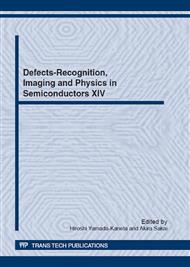[1]
M. Yamaguchi, III-V compound multi-junction solar cell: present and future, Sol. Energy Mater. Sol. Cells 75 (2003) 261-269.
DOI: 10.1016/s0927-0248(02)00168-x
Google Scholar
[2]
Information on http://www.sj-solar.com/
Google Scholar
[3]
K. Araki, M. Hiramatsu, H. Ito, Y. Kemmoku, and M. Yamaguchi, A 1,340X (GCR) Concentrator PV Module With a Dome-shaped Fresnel Lens Made by Injection Molding and a Kaleidoscope Secondary Made by Thermal Process, Proc. 22nd European Photovoltaic Solar Energy Conf. (2007) 148-152.
Google Scholar
[4]
J. Jaus, G. Peharz, A. Gombert, J. P. F. Rodriguez, F. Dimroth, F. Eltermann, O. Wolf, M. Passig, G. Siefer, A. Hakenjos, S. V. Riesen, A. and W. Bett, Development of FLATCON modules using secondary optics, Proc. 34th IEEE Photovoltaic Specialists Conf. (2009) 1931-1936.
DOI: 10.1109/pvsc.2009.5411559
Google Scholar
[5]
K. Araki, and M. Yamaguchi, Extended distributed model for analysis of non-ideal concentration operation, Sol. Energy Mater. Sol. Cells 75 (2003) 467–473.
DOI: 10.1016/s0927-0248(02)00203-9
Google Scholar
[6]
M. Victoria, C. Domínguez, I. Antón, and G. Sala, Comparative analysis of different secondary optical elements for aspheric primary lenses, Opt. Express 17 (2009) 6487-6492.
DOI: 10.1364/oe.17.006487
Google Scholar
[7]
M. Steiner, S. P. Philipps, M. Hermle, A. W. Bett, and F. Dimroth, Validated front contact grid simulation for GaAs solar cells under concentrated sunlight, Prog. Photovoltaics, 19 (2011) 73-83.
DOI: 10.1002/pip.989
Google Scholar
[8]
Y. Ota, and K. Nishioka, 3-Dimensional Simulator for Concentrator Photovoltaic Modules using Ray-Trace and Circuit Simulator, Proc. 35th Photovoltaic Specialists Conf. (2010) 3065-3068.
DOI: 10.1109/pvsc.2010.5614504
Google Scholar
[9]
Y. Ota, and K. Nishioka, Three-dimensional simulating of concentrator photovoltaic modules using ray trace and equivalent circuit simulators, Solae Energy, 86 (2012) 476-481.
DOI: 10.1016/j.solener.2011.10.021
Google Scholar
[10]
K. Nishioka, T. Takamoto, T. Agui, M. Kaneiwa, Y. Uraoka, and T. Fuyuki, Evaluation of InGaP/InGaAs/Ge triple-junction solar cell and optimization of solar cell's structure focusing on series resistance for high-efficiency concentrator photovoltaic systems, Sol. Energy Mater. Sol. Cells 90 (2006) 1308-1321.
DOI: 10.1016/j.solmat.2005.08.003
Google Scholar
[11]
K. Nishioka, T. Sueto, M. Uchida, and Y. Ota, Detailed Analysis of Temperature Characteristics of InGaP/InGaAs/Ge Triple Junction Solar Cell, J. Electron. Mater. 39 (2010) 704-708.
DOI: 10.1007/s11664-010-1171-y
Google Scholar


